Analysing Macro Environment and Internal Capabilities of Unilever
VerifiedAdded on 2023/01/11
|17
|5372
|70
AI Summary
This report analyzes the macro environment and internal capabilities of Unilever, a British multinational consumer goods company. It includes a PESTEL analysis of the macro environment and a SWOT analysis of the internal capabilities of the company.
Contribute Materials
Your contribution can guide someone’s learning journey. Share your
documents today.
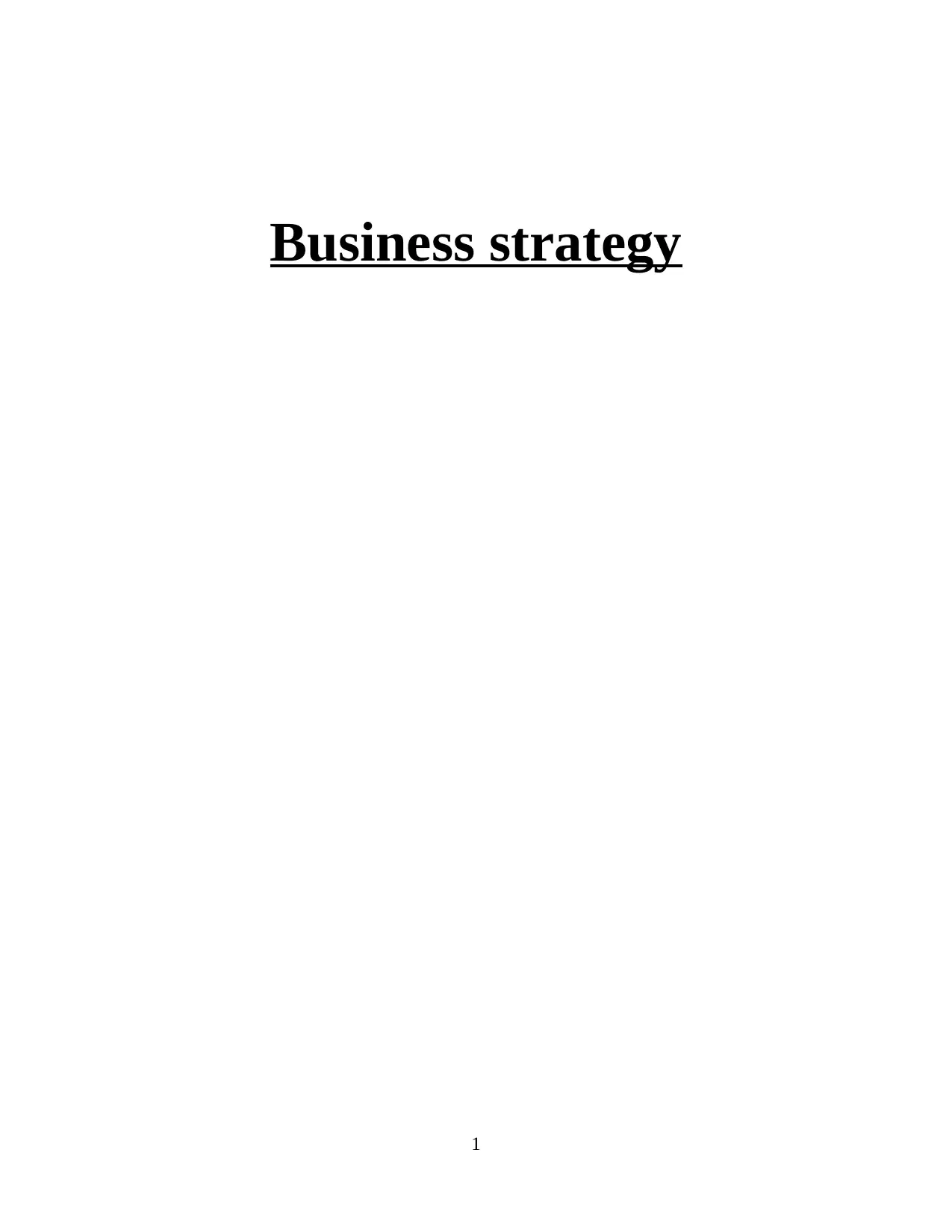
Business strategy
1
1
Secure Best Marks with AI Grader
Need help grading? Try our AI Grader for instant feedback on your assignments.

Table of Contents
INTRODUCTION...........................................................................................................................3
LO 1.................................................................................................................................................3
P1 Analyses macro environment of Unilever..............................................................................3
LO 2.................................................................................................................................................6
P2 Analyses the internal environment and capabilities...............................................................6
LO 3.................................................................................................................................................8
P3 Porter five force and evaluate competitive forces for organization.......................................8
LO 4...............................................................................................................................................10
P4 Range of theories, models and strategic planning for organization.....................................10
CONCLUSION..............................................................................................................................13
REFERENCES..............................................................................................................................14
2
INTRODUCTION...........................................................................................................................3
LO 1.................................................................................................................................................3
P1 Analyses macro environment of Unilever..............................................................................3
LO 2.................................................................................................................................................6
P2 Analyses the internal environment and capabilities...............................................................6
LO 3.................................................................................................................................................8
P3 Porter five force and evaluate competitive forces for organization.......................................8
LO 4...............................................................................................................................................10
P4 Range of theories, models and strategic planning for organization.....................................10
CONCLUSION..............................................................................................................................13
REFERENCES..............................................................................................................................14
2
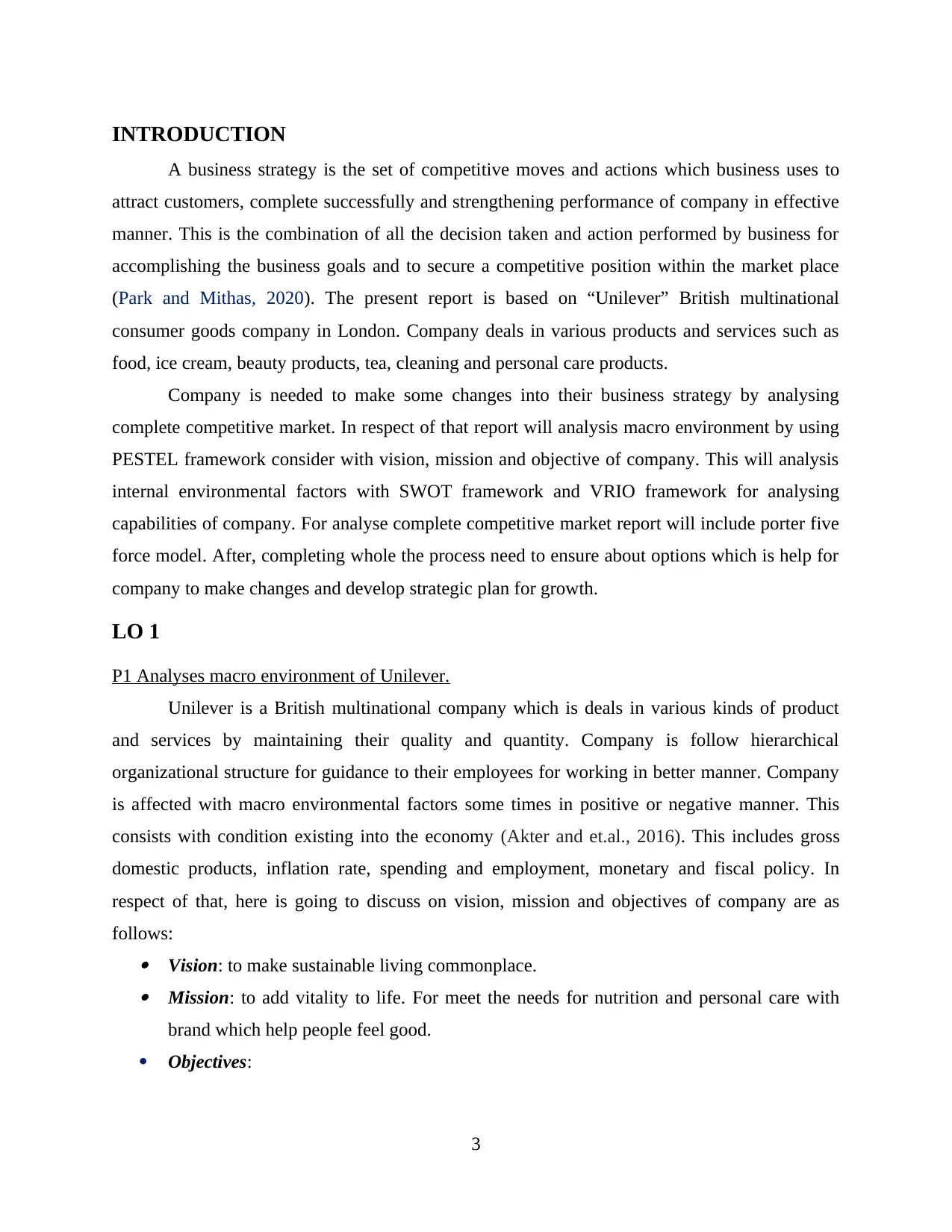
INTRODUCTION
A business strategy is the set of competitive moves and actions which business uses to
attract customers, complete successfully and strengthening performance of company in effective
manner. This is the combination of all the decision taken and action performed by business for
accomplishing the business goals and to secure a competitive position within the market place
(Park and Mithas, 2020). The present report is based on “Unilever” British multinational
consumer goods company in London. Company deals in various products and services such as
food, ice cream, beauty products, tea, cleaning and personal care products.
Company is needed to make some changes into their business strategy by analysing
complete competitive market. In respect of that report will analysis macro environment by using
PESTEL framework consider with vision, mission and objective of company. This will analysis
internal environmental factors with SWOT framework and VRIO framework for analysing
capabilities of company. For analyse complete competitive market report will include porter five
force model. After, completing whole the process need to ensure about options which is help for
company to make changes and develop strategic plan for growth.
LO 1
P1 Analyses macro environment of Unilever.
Unilever is a British multinational company which is deals in various kinds of product
and services by maintaining their quality and quantity. Company is follow hierarchical
organizational structure for guidance to their employees for working in better manner. Company
is affected with macro environmental factors some times in positive or negative manner. This
consists with condition existing into the economy (Akter and et.al., 2016). This includes gross
domestic products, inflation rate, spending and employment, monetary and fiscal policy. In
respect of that, here is going to discuss on vision, mission and objectives of company are as
follows: Vision: to make sustainable living commonplace. Mission: to add vitality to life. For meet the needs for nutrition and personal care with
brand which help people feel good.
Objectives:
3
A business strategy is the set of competitive moves and actions which business uses to
attract customers, complete successfully and strengthening performance of company in effective
manner. This is the combination of all the decision taken and action performed by business for
accomplishing the business goals and to secure a competitive position within the market place
(Park and Mithas, 2020). The present report is based on “Unilever” British multinational
consumer goods company in London. Company deals in various products and services such as
food, ice cream, beauty products, tea, cleaning and personal care products.
Company is needed to make some changes into their business strategy by analysing
complete competitive market. In respect of that report will analysis macro environment by using
PESTEL framework consider with vision, mission and objective of company. This will analysis
internal environmental factors with SWOT framework and VRIO framework for analysing
capabilities of company. For analyse complete competitive market report will include porter five
force model. After, completing whole the process need to ensure about options which is help for
company to make changes and develop strategic plan for growth.
LO 1
P1 Analyses macro environment of Unilever.
Unilever is a British multinational company which is deals in various kinds of product
and services by maintaining their quality and quantity. Company is follow hierarchical
organizational structure for guidance to their employees for working in better manner. Company
is affected with macro environmental factors some times in positive or negative manner. This
consists with condition existing into the economy (Akter and et.al., 2016). This includes gross
domestic products, inflation rate, spending and employment, monetary and fiscal policy. In
respect of that, here is going to discuss on vision, mission and objectives of company are as
follows: Vision: to make sustainable living commonplace. Mission: to add vitality to life. For meet the needs for nutrition and personal care with
brand which help people feel good.
Objectives:
3

o To help approximately 40 % of the consumer to improve their health and
wellbeing by the end of 2020.
o To improve livelihoods of 45 % of the population in the supply chain of the goods
and services till November 2020.
o To decrease the carbon footprint by 20 % from the manufacturing of the goods
and services by the company till January 2021.
Those are vision, mission and objectives of Unilever Company and believe this is the best
long terms way for our business to grow at market place. The mission of company is help to add
the vitality for life of customers as well as improve life of various peoples. With the help of this,
company is able to attract more customers because working in it is highly good and effective.
Business strategy is providing better opportunity to Unilever for getting success. Company face
hard competition into the market place. In that, management need to prepare competitive price
strategy through analysing macro environmental factors. For analysing macro environmental
factors here is select PESTEL framework and stakeholder analysis.
A PESTEL framework is used by company to analyse and monitor complete macro
environmental factors which have impact on organization (Angeloska-Dichovska and Petkovska-
Mirchevska, 2017). Analyse of PESTEL, in context of Unilever are as follows:
Political factor:
Unilever operates across worldwide with having various employees. This factor is
consisting with all the government taxes and rate like corporate tax, government tax, etc. and
some of political party’s business policy. In some nations political power have a clear majority
and less for performing task. In the case of fewer majorities are help to take best and effective
decision easily. Like the sales activities through supply chain management is affected through
political factor which is lead to economic stability. That is help to turn into the better sales and
profits of company in effective manner. on the other side, political factor is affect to sales of
company when government is increase tax rate on goods, exports and imports because tax rate
increase than price of product is also increases.
Economic factor:
Economic factor is referring with economic condition of country and global economy.
The economy condition is more profitable and for revenue. Through that, company have higher
chance to get more success at market place within the developing country (PESTEL analysis of
4
wellbeing by the end of 2020.
o To improve livelihoods of 45 % of the population in the supply chain of the goods
and services till November 2020.
o To decrease the carbon footprint by 20 % from the manufacturing of the goods
and services by the company till January 2021.
Those are vision, mission and objectives of Unilever Company and believe this is the best
long terms way for our business to grow at market place. The mission of company is help to add
the vitality for life of customers as well as improve life of various peoples. With the help of this,
company is able to attract more customers because working in it is highly good and effective.
Business strategy is providing better opportunity to Unilever for getting success. Company face
hard competition into the market place. In that, management need to prepare competitive price
strategy through analysing macro environmental factors. For analysing macro environmental
factors here is select PESTEL framework and stakeholder analysis.
A PESTEL framework is used by company to analyse and monitor complete macro
environmental factors which have impact on organization (Angeloska-Dichovska and Petkovska-
Mirchevska, 2017). Analyse of PESTEL, in context of Unilever are as follows:
Political factor:
Unilever operates across worldwide with having various employees. This factor is
consisting with all the government taxes and rate like corporate tax, government tax, etc. and
some of political party’s business policy. In some nations political power have a clear majority
and less for performing task. In the case of fewer majorities are help to take best and effective
decision easily. Like the sales activities through supply chain management is affected through
political factor which is lead to economic stability. That is help to turn into the better sales and
profits of company in effective manner. on the other side, political factor is affect to sales of
company when government is increase tax rate on goods, exports and imports because tax rate
increase than price of product is also increases.
Economic factor:
Economic factor is referring with economic condition of country and global economy.
The economy condition is more profitable and for revenue. Through that, company have higher
chance to get more success at market place within the developing country (PESTEL analysis of
4
Secure Best Marks with AI Grader
Need help grading? Try our AI Grader for instant feedback on your assignments.
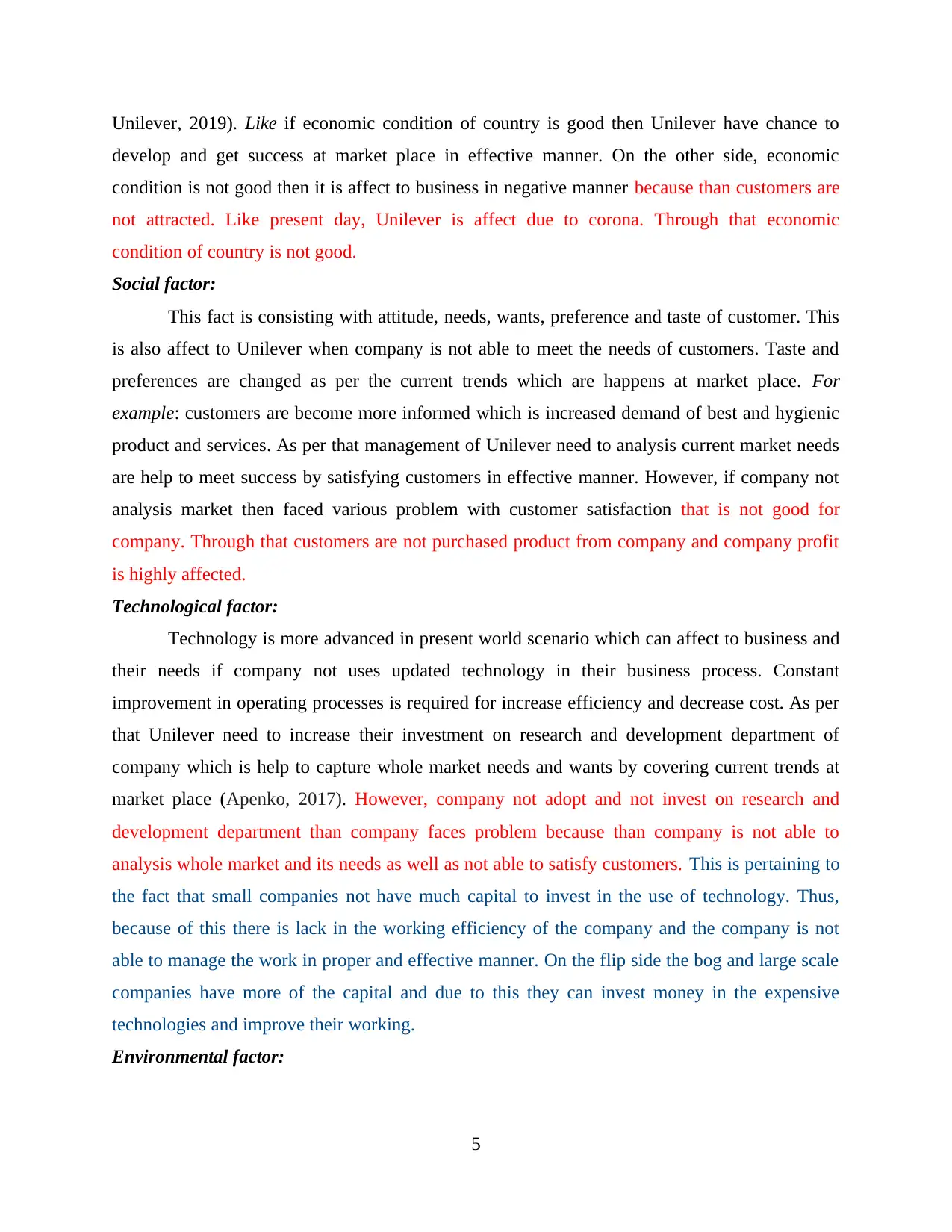
Unilever, 2019). Like if economic condition of country is good then Unilever have chance to
develop and get success at market place in effective manner. On the other side, economic
condition is not good then it is affect to business in negative manner because than customers are
not attracted. Like present day, Unilever is affect due to corona. Through that economic
condition of country is not good.
Social factor:
This fact is consisting with attitude, needs, wants, preference and taste of customer. This
is also affect to Unilever when company is not able to meet the needs of customers. Taste and
preferences are changed as per the current trends which are happens at market place. For
example: customers are become more informed which is increased demand of best and hygienic
product and services. As per that management of Unilever need to analysis current market needs
are help to meet success by satisfying customers in effective manner. However, if company not
analysis market then faced various problem with customer satisfaction that is not good for
company. Through that customers are not purchased product from company and company profit
is highly affected.
Technological factor:
Technology is more advanced in present world scenario which can affect to business and
their needs if company not uses updated technology in their business process. Constant
improvement in operating processes is required for increase efficiency and decrease cost. As per
that Unilever need to increase their investment on research and development department of
company which is help to capture whole market needs and wants by covering current trends at
market place (Apenko, 2017). However, company not adopt and not invest on research and
development department than company faces problem because than company is not able to
analysis whole market and its needs as well as not able to satisfy customers. This is pertaining to
the fact that small companies not have much capital to invest in the use of technology. Thus,
because of this there is lack in the working efficiency of the company and the company is not
able to manage the work in proper and effective manner. On the flip side the bog and large scale
companies have more of the capital and due to this they can invest money in the expensive
technologies and improve their working.
Environmental factor:
5
develop and get success at market place in effective manner. On the other side, economic
condition is not good then it is affect to business in negative manner because than customers are
not attracted. Like present day, Unilever is affect due to corona. Through that economic
condition of country is not good.
Social factor:
This fact is consisting with attitude, needs, wants, preference and taste of customer. This
is also affect to Unilever when company is not able to meet the needs of customers. Taste and
preferences are changed as per the current trends which are happens at market place. For
example: customers are become more informed which is increased demand of best and hygienic
product and services. As per that management of Unilever need to analysis current market needs
are help to meet success by satisfying customers in effective manner. However, if company not
analysis market then faced various problem with customer satisfaction that is not good for
company. Through that customers are not purchased product from company and company profit
is highly affected.
Technological factor:
Technology is more advanced in present world scenario which can affect to business and
their needs if company not uses updated technology in their business process. Constant
improvement in operating processes is required for increase efficiency and decrease cost. As per
that Unilever need to increase their investment on research and development department of
company which is help to capture whole market needs and wants by covering current trends at
market place (Apenko, 2017). However, company not adopt and not invest on research and
development department than company faces problem because than company is not able to
analysis whole market and its needs as well as not able to satisfy customers. This is pertaining to
the fact that small companies not have much capital to invest in the use of technology. Thus,
because of this there is lack in the working efficiency of the company and the company is not
able to manage the work in proper and effective manner. On the flip side the bog and large scale
companies have more of the capital and due to this they can invest money in the expensive
technologies and improve their working.
Environmental factor:
5
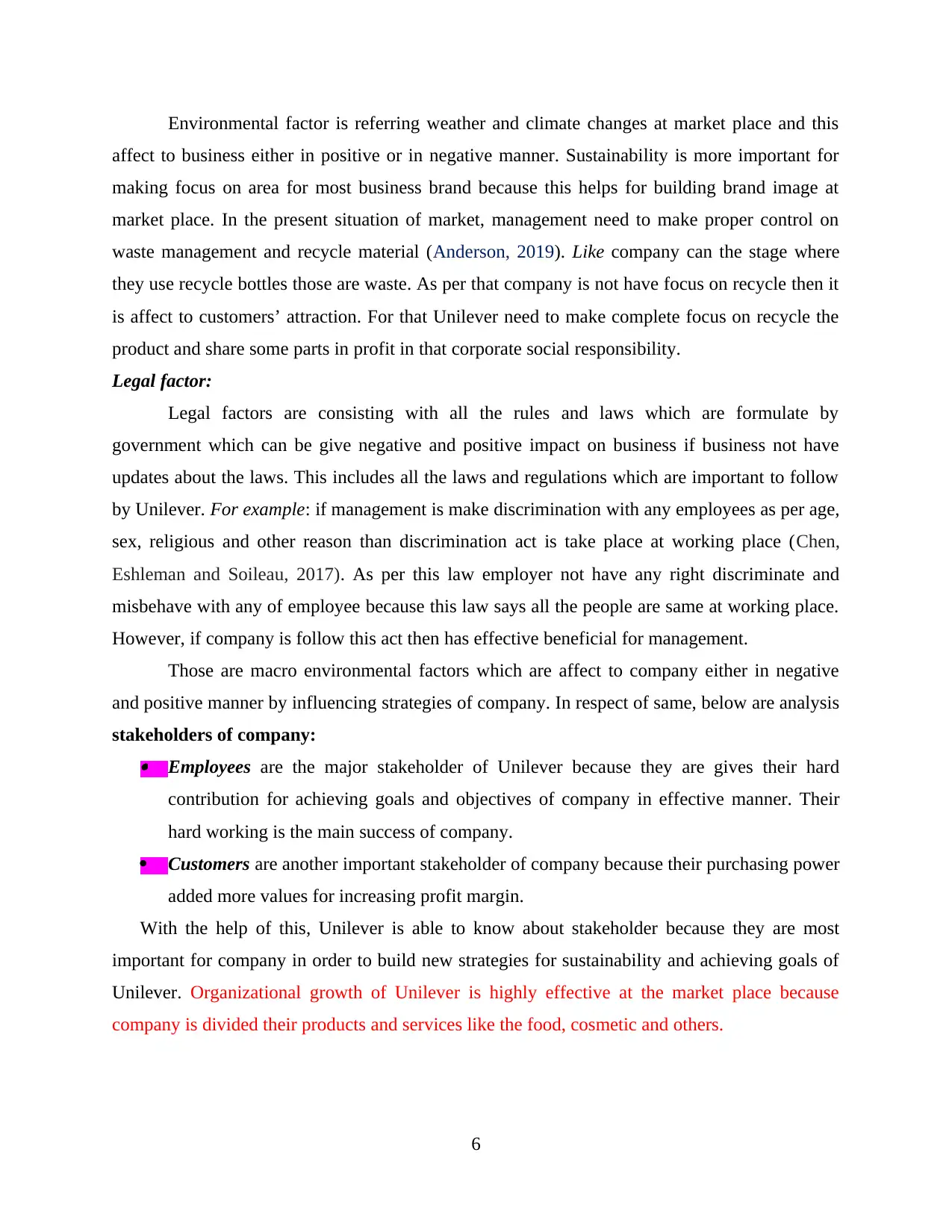
Environmental factor is referring weather and climate changes at market place and this
affect to business either in positive or in negative manner. Sustainability is more important for
making focus on area for most business brand because this helps for building brand image at
market place. In the present situation of market, management need to make proper control on
waste management and recycle material (Anderson, 2019). Like company can the stage where
they use recycle bottles those are waste. As per that company is not have focus on recycle then it
is affect to customers’ attraction. For that Unilever need to make complete focus on recycle the
product and share some parts in profit in that corporate social responsibility.
Legal factor:
Legal factors are consisting with all the rules and laws which are formulate by
government which can be give negative and positive impact on business if business not have
updates about the laws. This includes all the laws and regulations which are important to follow
by Unilever. For example: if management is make discrimination with any employees as per age,
sex, religious and other reason than discrimination act is take place at working place (Chen,
Eshleman and Soileau, 2017). As per this law employer not have any right discriminate and
misbehave with any of employee because this law says all the people are same at working place.
However, if company is follow this act then has effective beneficial for management.
Those are macro environmental factors which are affect to company either in negative
and positive manner by influencing strategies of company. In respect of same, below are analysis
stakeholders of company: Employees are the major stakeholder of Unilever because they are gives their hard
contribution for achieving goals and objectives of company in effective manner. Their
hard working is the main success of company.
Customers are another important stakeholder of company because their purchasing power
added more values for increasing profit margin.
With the help of this, Unilever is able to know about stakeholder because they are most
important for company in order to build new strategies for sustainability and achieving goals of
Unilever. Organizational growth of Unilever is highly effective at the market place because
company is divided their products and services like the food, cosmetic and others.
6
affect to business either in positive or in negative manner. Sustainability is more important for
making focus on area for most business brand because this helps for building brand image at
market place. In the present situation of market, management need to make proper control on
waste management and recycle material (Anderson, 2019). Like company can the stage where
they use recycle bottles those are waste. As per that company is not have focus on recycle then it
is affect to customers’ attraction. For that Unilever need to make complete focus on recycle the
product and share some parts in profit in that corporate social responsibility.
Legal factor:
Legal factors are consisting with all the rules and laws which are formulate by
government which can be give negative and positive impact on business if business not have
updates about the laws. This includes all the laws and regulations which are important to follow
by Unilever. For example: if management is make discrimination with any employees as per age,
sex, religious and other reason than discrimination act is take place at working place (Chen,
Eshleman and Soileau, 2017). As per this law employer not have any right discriminate and
misbehave with any of employee because this law says all the people are same at working place.
However, if company is follow this act then has effective beneficial for management.
Those are macro environmental factors which are affect to company either in negative
and positive manner by influencing strategies of company. In respect of same, below are analysis
stakeholders of company: Employees are the major stakeholder of Unilever because they are gives their hard
contribution for achieving goals and objectives of company in effective manner. Their
hard working is the main success of company.
Customers are another important stakeholder of company because their purchasing power
added more values for increasing profit margin.
With the help of this, Unilever is able to know about stakeholder because they are most
important for company in order to build new strategies for sustainability and achieving goals of
Unilever. Organizational growth of Unilever is highly effective at the market place because
company is divided their products and services like the food, cosmetic and others.
6
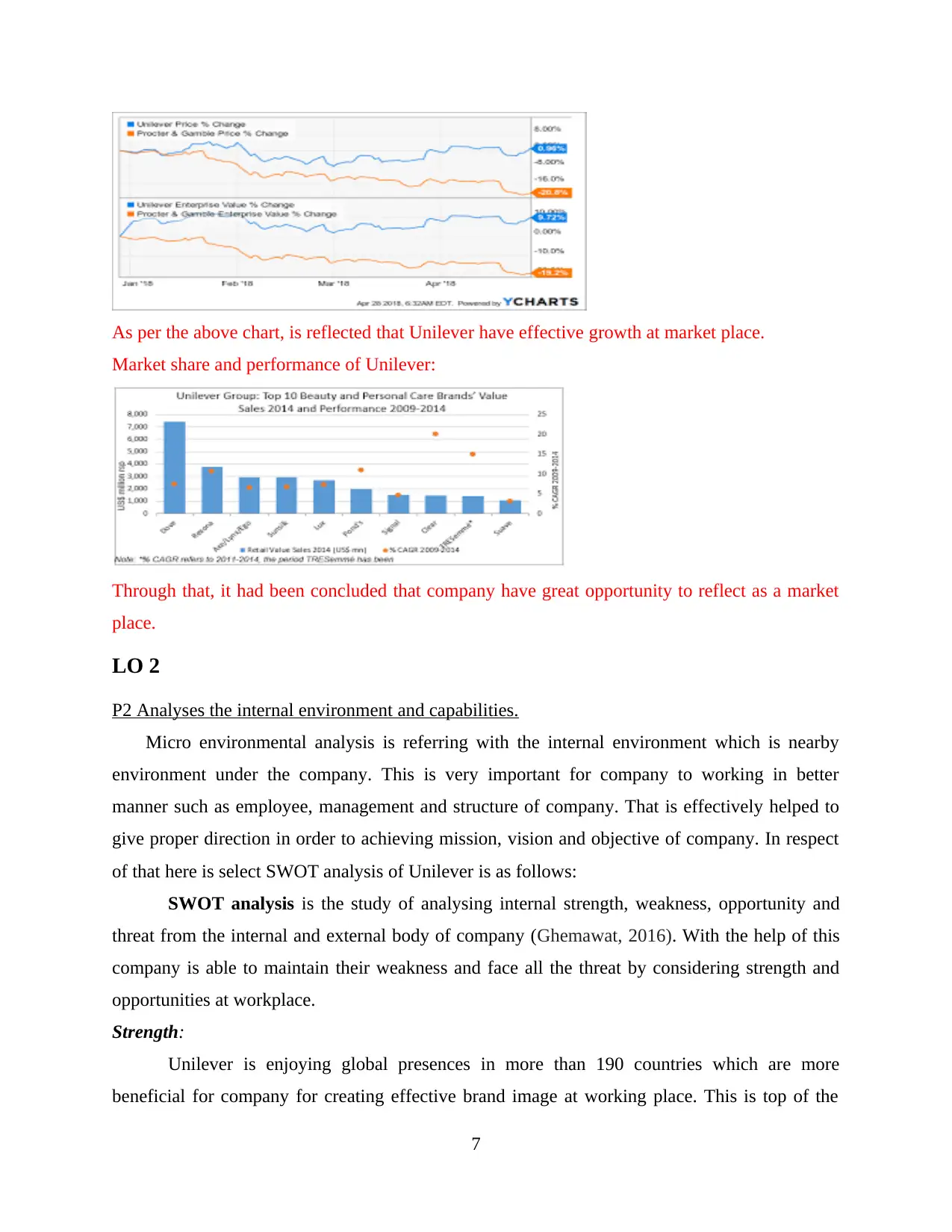
As per the above chart, is reflected that Unilever have effective growth at market place.
Market share and performance of Unilever:
Through that, it had been concluded that company have great opportunity to reflect as a market
place.
LO 2
P2 Analyses the internal environment and capabilities.
Micro environmental analysis is referring with the internal environment which is nearby
environment under the company. This is very important for company to working in better
manner such as employee, management and structure of company. That is effectively helped to
give proper direction in order to achieving mission, vision and objective of company. In respect
of that here is select SWOT analysis of Unilever is as follows:
SWOT analysis is the study of analysing internal strength, weakness, opportunity and
threat from the internal and external body of company (Ghemawat, 2016). With the help of this
company is able to maintain their weakness and face all the threat by considering strength and
opportunities at workplace.
Strength:
Unilever is enjoying global presences in more than 190 countries which are more
beneficial for company for creating effective brand image at working place. This is top of the
7
Market share and performance of Unilever:
Through that, it had been concluded that company have great opportunity to reflect as a market
place.
LO 2
P2 Analyses the internal environment and capabilities.
Micro environmental analysis is referring with the internal environment which is nearby
environment under the company. This is very important for company to working in better
manner such as employee, management and structure of company. That is effectively helped to
give proper direction in order to achieving mission, vision and objective of company. In respect
of that here is select SWOT analysis of Unilever is as follows:
SWOT analysis is the study of analysing internal strength, weakness, opportunity and
threat from the internal and external body of company (Ghemawat, 2016). With the help of this
company is able to maintain their weakness and face all the threat by considering strength and
opportunities at workplace.
Strength:
Unilever is enjoying global presences in more than 190 countries which are more
beneficial for company for creating effective brand image at working place. This is top of the
7
Paraphrase This Document
Need a fresh take? Get an instant paraphrase of this document with our AI Paraphraser
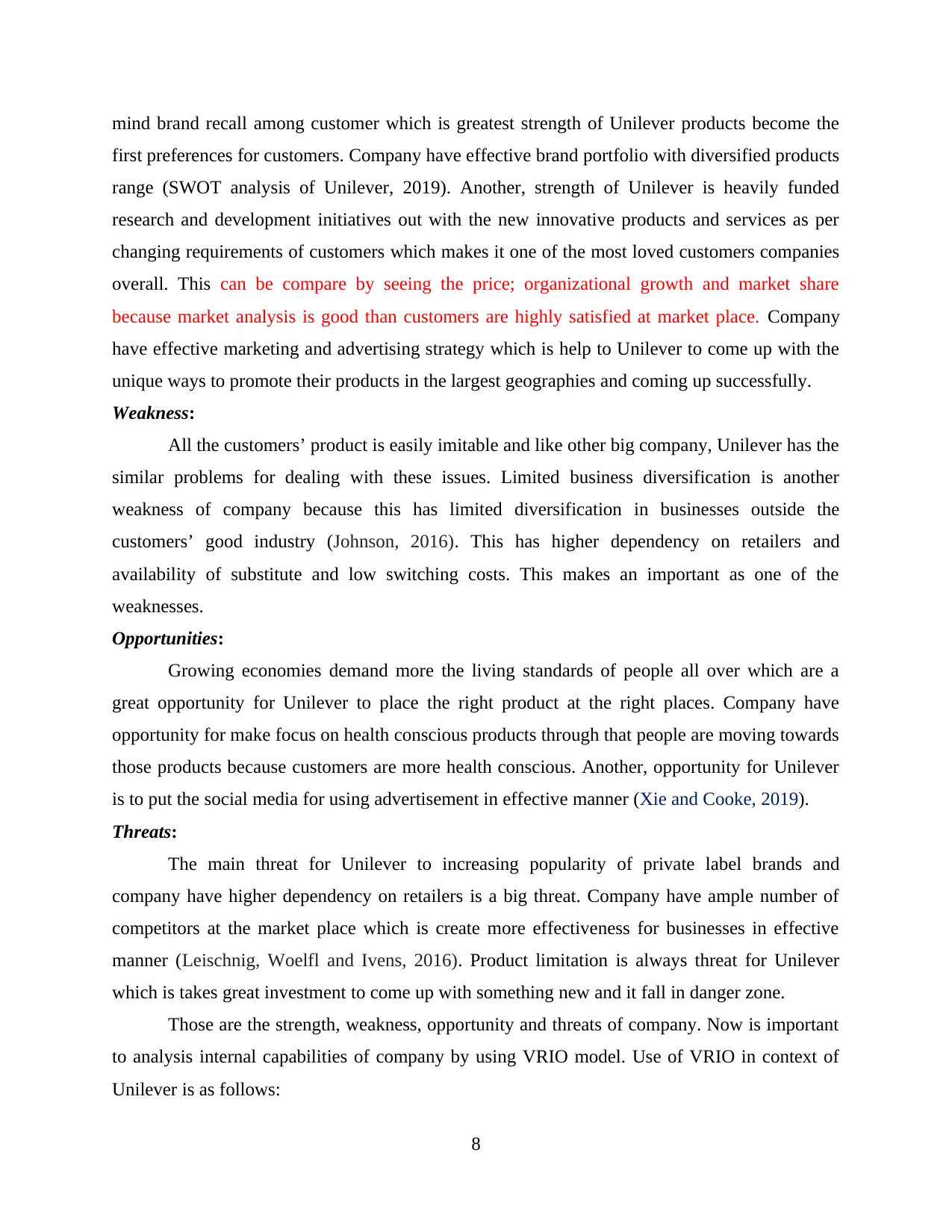
mind brand recall among customer which is greatest strength of Unilever products become the
first preferences for customers. Company have effective brand portfolio with diversified products
range (SWOT analysis of Unilever, 2019). Another, strength of Unilever is heavily funded
research and development initiatives out with the new innovative products and services as per
changing requirements of customers which makes it one of the most loved customers companies
overall. This can be compare by seeing the price; organizational growth and market share
because market analysis is good than customers are highly satisfied at market place. Company
have effective marketing and advertising strategy which is help to Unilever to come up with the
unique ways to promote their products in the largest geographies and coming up successfully.
Weakness:
All the customers’ product is easily imitable and like other big company, Unilever has the
similar problems for dealing with these issues. Limited business diversification is another
weakness of company because this has limited diversification in businesses outside the
customers’ good industry (Johnson, 2016). This has higher dependency on retailers and
availability of substitute and low switching costs. This makes an important as one of the
weaknesses.
Opportunities:
Growing economies demand more the living standards of people all over which are a
great opportunity for Unilever to place the right product at the right places. Company have
opportunity for make focus on health conscious products through that people are moving towards
those products because customers are more health conscious. Another, opportunity for Unilever
is to put the social media for using advertisement in effective manner (Xie and Cooke, 2019).
Threats:
The main threat for Unilever to increasing popularity of private label brands and
company have higher dependency on retailers is a big threat. Company have ample number of
competitors at the market place which is create more effectiveness for businesses in effective
manner (Leischnig, Woelfl and Ivens, 2016). Product limitation is always threat for Unilever
which is takes great investment to come up with something new and it fall in danger zone.
Those are the strength, weakness, opportunity and threats of company. Now is important
to analysis internal capabilities of company by using VRIO model. Use of VRIO in context of
Unilever is as follows:
8
first preferences for customers. Company have effective brand portfolio with diversified products
range (SWOT analysis of Unilever, 2019). Another, strength of Unilever is heavily funded
research and development initiatives out with the new innovative products and services as per
changing requirements of customers which makes it one of the most loved customers companies
overall. This can be compare by seeing the price; organizational growth and market share
because market analysis is good than customers are highly satisfied at market place. Company
have effective marketing and advertising strategy which is help to Unilever to come up with the
unique ways to promote their products in the largest geographies and coming up successfully.
Weakness:
All the customers’ product is easily imitable and like other big company, Unilever has the
similar problems for dealing with these issues. Limited business diversification is another
weakness of company because this has limited diversification in businesses outside the
customers’ good industry (Johnson, 2016). This has higher dependency on retailers and
availability of substitute and low switching costs. This makes an important as one of the
weaknesses.
Opportunities:
Growing economies demand more the living standards of people all over which are a
great opportunity for Unilever to place the right product at the right places. Company have
opportunity for make focus on health conscious products through that people are moving towards
those products because customers are more health conscious. Another, opportunity for Unilever
is to put the social media for using advertisement in effective manner (Xie and Cooke, 2019).
Threats:
The main threat for Unilever to increasing popularity of private label brands and
company have higher dependency on retailers is a big threat. Company have ample number of
competitors at the market place which is create more effectiveness for businesses in effective
manner (Leischnig, Woelfl and Ivens, 2016). Product limitation is always threat for Unilever
which is takes great investment to come up with something new and it fall in danger zone.
Those are the strength, weakness, opportunity and threats of company. Now is important
to analysis internal capabilities of company by using VRIO model. Use of VRIO in context of
Unilever is as follows:
8
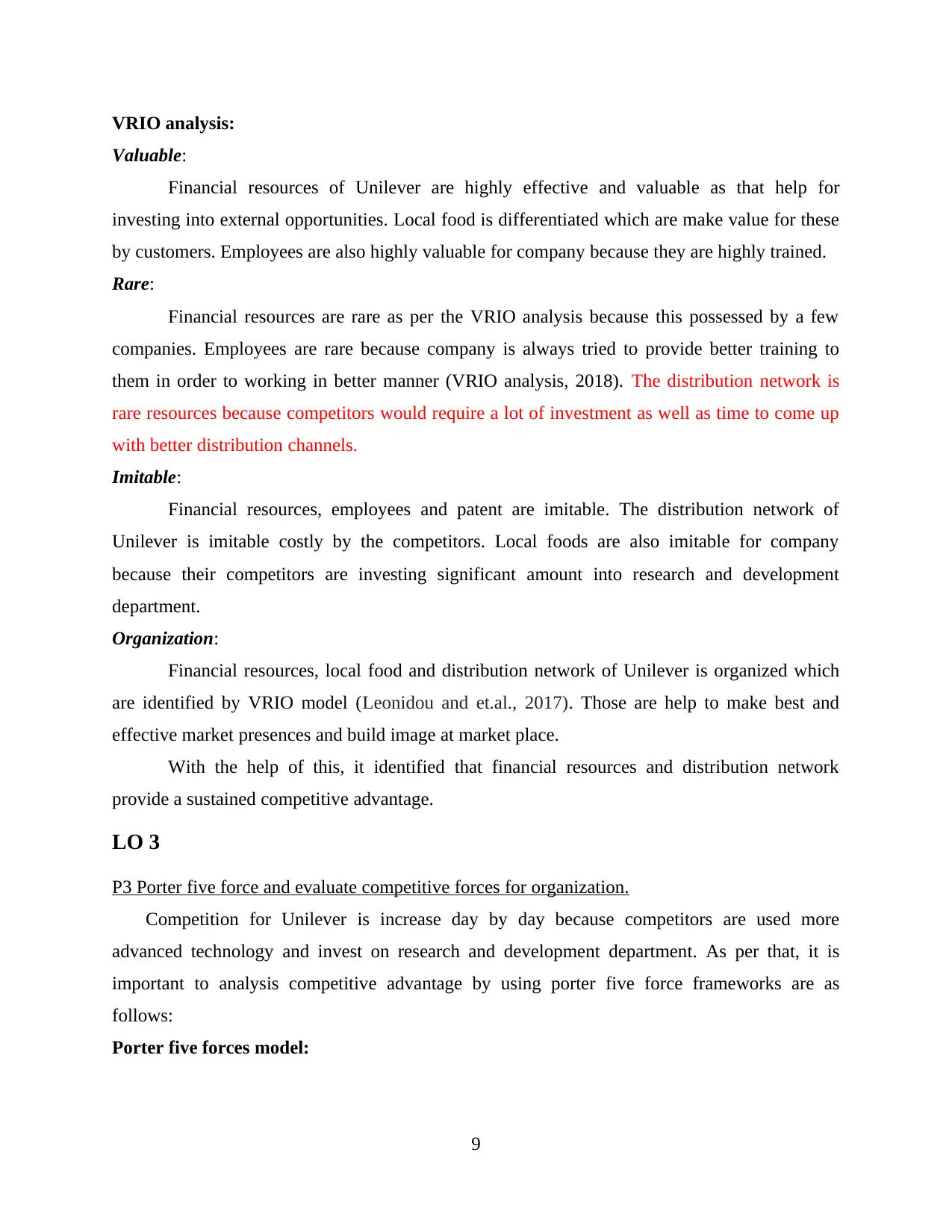
VRIO analysis:
Valuable:
Financial resources of Unilever are highly effective and valuable as that help for
investing into external opportunities. Local food is differentiated which are make value for these
by customers. Employees are also highly valuable for company because they are highly trained.
Rare:
Financial resources are rare as per the VRIO analysis because this possessed by a few
companies. Employees are rare because company is always tried to provide better training to
them in order to working in better manner (VRIO analysis, 2018). The distribution network is
rare resources because competitors would require a lot of investment as well as time to come up
with better distribution channels.
Imitable:
Financial resources, employees and patent are imitable. The distribution network of
Unilever is imitable costly by the competitors. Local foods are also imitable for company
because their competitors are investing significant amount into research and development
department.
Organization:
Financial resources, local food and distribution network of Unilever is organized which
are identified by VRIO model (Leonidou and et.al., 2017). Those are help to make best and
effective market presences and build image at market place.
With the help of this, it identified that financial resources and distribution network
provide a sustained competitive advantage.
LO 3
P3 Porter five force and evaluate competitive forces for organization.
Competition for Unilever is increase day by day because competitors are used more
advanced technology and invest on research and development department. As per that, it is
important to analysis competitive advantage by using porter five force frameworks are as
follows:
Porter five forces model:
9
Valuable:
Financial resources of Unilever are highly effective and valuable as that help for
investing into external opportunities. Local food is differentiated which are make value for these
by customers. Employees are also highly valuable for company because they are highly trained.
Rare:
Financial resources are rare as per the VRIO analysis because this possessed by a few
companies. Employees are rare because company is always tried to provide better training to
them in order to working in better manner (VRIO analysis, 2018). The distribution network is
rare resources because competitors would require a lot of investment as well as time to come up
with better distribution channels.
Imitable:
Financial resources, employees and patent are imitable. The distribution network of
Unilever is imitable costly by the competitors. Local foods are also imitable for company
because their competitors are investing significant amount into research and development
department.
Organization:
Financial resources, local food and distribution network of Unilever is organized which
are identified by VRIO model (Leonidou and et.al., 2017). Those are help to make best and
effective market presences and build image at market place.
With the help of this, it identified that financial resources and distribution network
provide a sustained competitive advantage.
LO 3
P3 Porter five force and evaluate competitive forces for organization.
Competition for Unilever is increase day by day because competitors are used more
advanced technology and invest on research and development department. As per that, it is
important to analysis competitive advantage by using porter five force frameworks are as
follows:
Porter five forces model:
9
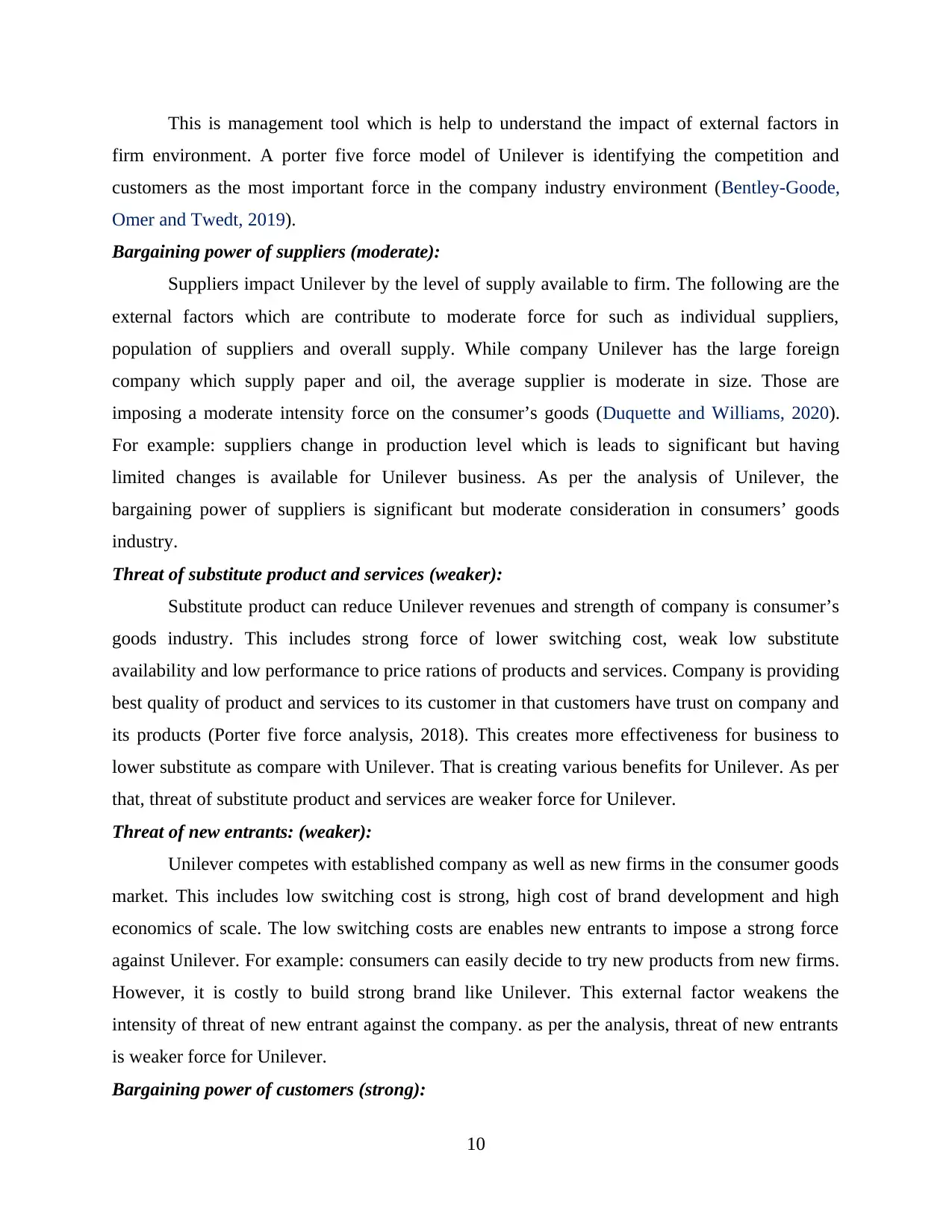
This is management tool which is help to understand the impact of external factors in
firm environment. A porter five force model of Unilever is identifying the competition and
customers as the most important force in the company industry environment (Bentley-Goode,
Omer and Twedt, 2019).
Bargaining power of suppliers (moderate):
Suppliers impact Unilever by the level of supply available to firm. The following are the
external factors which are contribute to moderate force for such as individual suppliers,
population of suppliers and overall supply. While company Unilever has the large foreign
company which supply paper and oil, the average supplier is moderate in size. Those are
imposing a moderate intensity force on the consumer’s goods (Duquette and Williams, 2020).
For example: suppliers change in production level which is leads to significant but having
limited changes is available for Unilever business. As per the analysis of Unilever, the
bargaining power of suppliers is significant but moderate consideration in consumers’ goods
industry.
Threat of substitute product and services (weaker):
Substitute product can reduce Unilever revenues and strength of company is consumer’s
goods industry. This includes strong force of lower switching cost, weak low substitute
availability and low performance to price rations of products and services. Company is providing
best quality of product and services to its customer in that customers have trust on company and
its products (Porter five force analysis, 2018). This creates more effectiveness for business to
lower substitute as compare with Unilever. That is creating various benefits for Unilever. As per
that, threat of substitute product and services are weaker force for Unilever.
Threat of new entrants: (weaker):
Unilever competes with established company as well as new firms in the consumer goods
market. This includes low switching cost is strong, high cost of brand development and high
economics of scale. The low switching costs are enables new entrants to impose a strong force
against Unilever. For example: consumers can easily decide to try new products from new firms.
However, it is costly to build strong brand like Unilever. This external factor weakens the
intensity of threat of new entrant against the company. as per the analysis, threat of new entrants
is weaker force for Unilever.
Bargaining power of customers (strong):
10
firm environment. A porter five force model of Unilever is identifying the competition and
customers as the most important force in the company industry environment (Bentley-Goode,
Omer and Twedt, 2019).
Bargaining power of suppliers (moderate):
Suppliers impact Unilever by the level of supply available to firm. The following are the
external factors which are contribute to moderate force for such as individual suppliers,
population of suppliers and overall supply. While company Unilever has the large foreign
company which supply paper and oil, the average supplier is moderate in size. Those are
imposing a moderate intensity force on the consumer’s goods (Duquette and Williams, 2020).
For example: suppliers change in production level which is leads to significant but having
limited changes is available for Unilever business. As per the analysis of Unilever, the
bargaining power of suppliers is significant but moderate consideration in consumers’ goods
industry.
Threat of substitute product and services (weaker):
Substitute product can reduce Unilever revenues and strength of company is consumer’s
goods industry. This includes strong force of lower switching cost, weak low substitute
availability and low performance to price rations of products and services. Company is providing
best quality of product and services to its customer in that customers have trust on company and
its products (Porter five force analysis, 2018). This creates more effectiveness for business to
lower substitute as compare with Unilever. That is creating various benefits for Unilever. As per
that, threat of substitute product and services are weaker force for Unilever.
Threat of new entrants: (weaker):
Unilever competes with established company as well as new firms in the consumer goods
market. This includes low switching cost is strong, high cost of brand development and high
economics of scale. The low switching costs are enables new entrants to impose a strong force
against Unilever. For example: consumers can easily decide to try new products from new firms.
However, it is costly to build strong brand like Unilever. This external factor weakens the
intensity of threat of new entrant against the company. as per the analysis, threat of new entrants
is weaker force for Unilever.
Bargaining power of customers (strong):
10
Secure Best Marks with AI Grader
Need help grading? Try our AI Grader for instant feedback on your assignments.
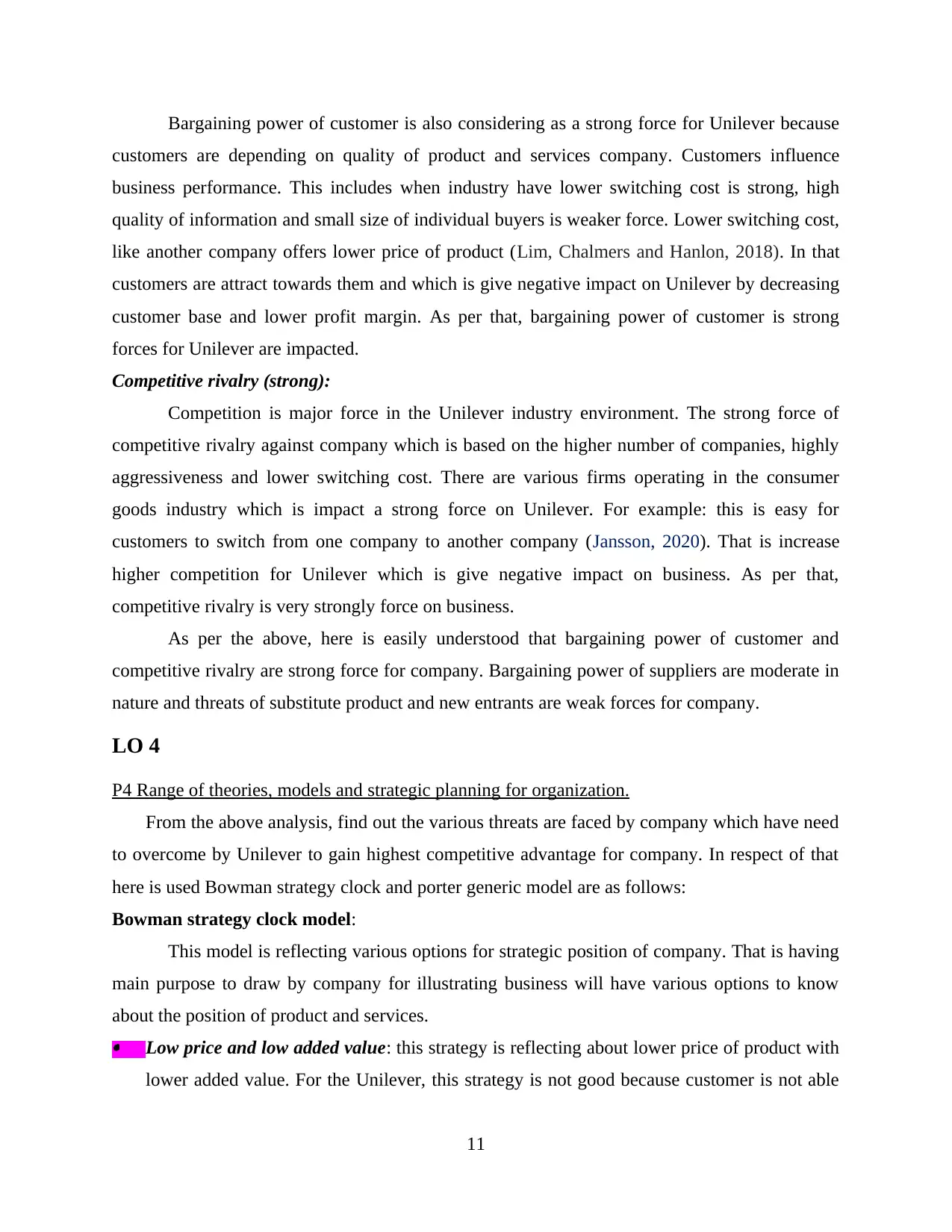
Bargaining power of customer is also considering as a strong force for Unilever because
customers are depending on quality of product and services company. Customers influence
business performance. This includes when industry have lower switching cost is strong, high
quality of information and small size of individual buyers is weaker force. Lower switching cost,
like another company offers lower price of product (Lim, Chalmers and Hanlon, 2018). In that
customers are attract towards them and which is give negative impact on Unilever by decreasing
customer base and lower profit margin. As per that, bargaining power of customer is strong
forces for Unilever are impacted.
Competitive rivalry (strong):
Competition is major force in the Unilever industry environment. The strong force of
competitive rivalry against company which is based on the higher number of companies, highly
aggressiveness and lower switching cost. There are various firms operating in the consumer
goods industry which is impact a strong force on Unilever. For example: this is easy for
customers to switch from one company to another company (Jansson, 2020). That is increase
higher competition for Unilever which is give negative impact on business. As per that,
competitive rivalry is very strongly force on business.
As per the above, here is easily understood that bargaining power of customer and
competitive rivalry are strong force for company. Bargaining power of suppliers are moderate in
nature and threats of substitute product and new entrants are weak forces for company.
LO 4
P4 Range of theories, models and strategic planning for organization.
From the above analysis, find out the various threats are faced by company which have need
to overcome by Unilever to gain highest competitive advantage for company. In respect of that
here is used Bowman strategy clock and porter generic model are as follows:
Bowman strategy clock model:
This model is reflecting various options for strategic position of company. That is having
main purpose to draw by company for illustrating business will have various options to know
about the position of product and services. Low price and low added value: this strategy is reflecting about lower price of product with
lower added value. For the Unilever, this strategy is not good because customer is not able
11
customers are depending on quality of product and services company. Customers influence
business performance. This includes when industry have lower switching cost is strong, high
quality of information and small size of individual buyers is weaker force. Lower switching cost,
like another company offers lower price of product (Lim, Chalmers and Hanlon, 2018). In that
customers are attract towards them and which is give negative impact on Unilever by decreasing
customer base and lower profit margin. As per that, bargaining power of customer is strong
forces for Unilever are impacted.
Competitive rivalry (strong):
Competition is major force in the Unilever industry environment. The strong force of
competitive rivalry against company which is based on the higher number of companies, highly
aggressiveness and lower switching cost. There are various firms operating in the consumer
goods industry which is impact a strong force on Unilever. For example: this is easy for
customers to switch from one company to another company (Jansson, 2020). That is increase
higher competition for Unilever which is give negative impact on business. As per that,
competitive rivalry is very strongly force on business.
As per the above, here is easily understood that bargaining power of customer and
competitive rivalry are strong force for company. Bargaining power of suppliers are moderate in
nature and threats of substitute product and new entrants are weak forces for company.
LO 4
P4 Range of theories, models and strategic planning for organization.
From the above analysis, find out the various threats are faced by company which have need
to overcome by Unilever to gain highest competitive advantage for company. In respect of that
here is used Bowman strategy clock and porter generic model are as follows:
Bowman strategy clock model:
This model is reflecting various options for strategic position of company. That is having
main purpose to draw by company for illustrating business will have various options to know
about the position of product and services. Low price and low added value: this strategy is reflecting about lower price of product with
lower added value. For the Unilever, this strategy is not good because customer is not able
11
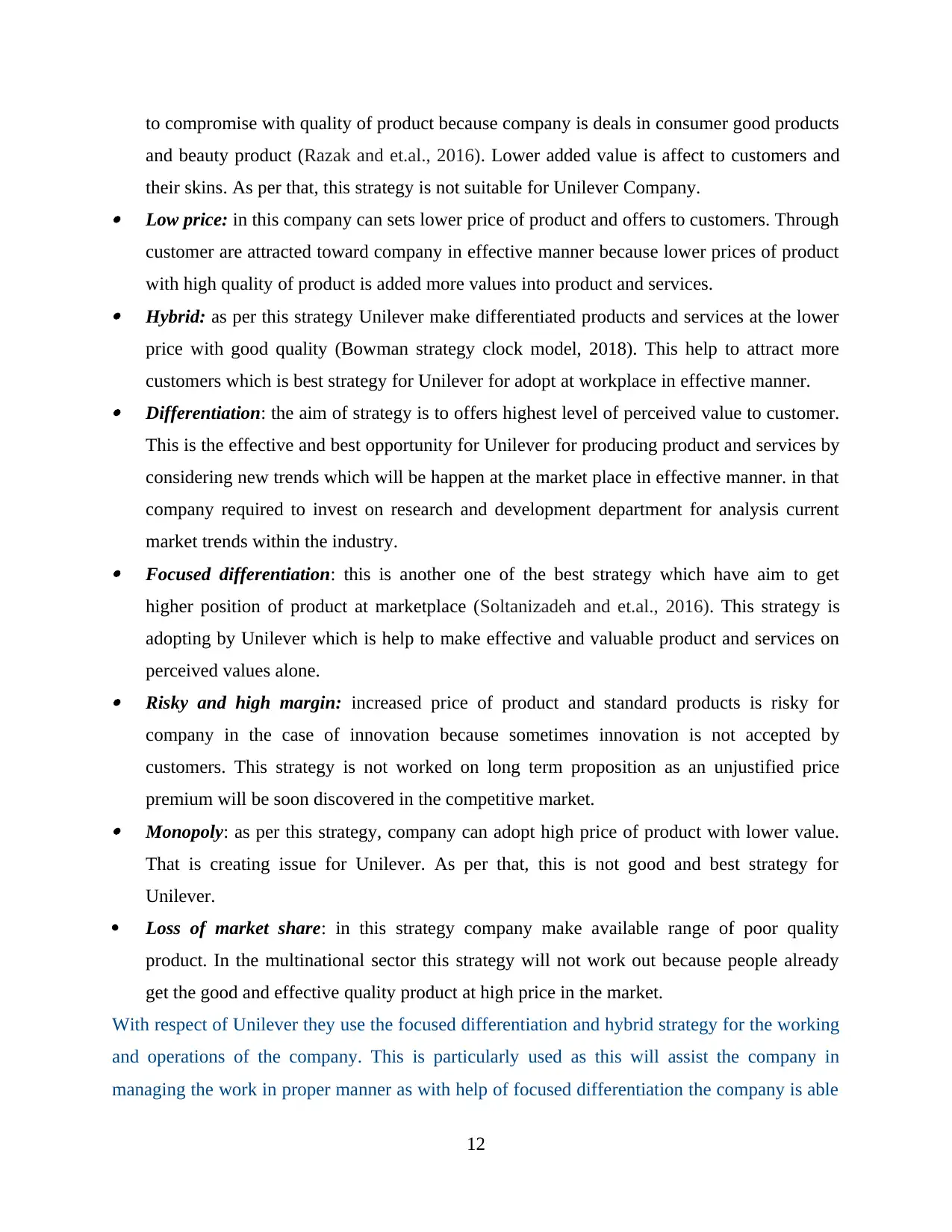
to compromise with quality of product because company is deals in consumer good products
and beauty product (Razak and et.al., 2016). Lower added value is affect to customers and
their skins. As per that, this strategy is not suitable for Unilever Company. Low price: in this company can sets lower price of product and offers to customers. Through
customer are attracted toward company in effective manner because lower prices of product
with high quality of product is added more values into product and services. Hybrid: as per this strategy Unilever make differentiated products and services at the lower
price with good quality (Bowman strategy clock model, 2018). This help to attract more
customers which is best strategy for Unilever for adopt at workplace in effective manner. Differentiation: the aim of strategy is to offers highest level of perceived value to customer.
This is the effective and best opportunity for Unilever for producing product and services by
considering new trends which will be happen at the market place in effective manner. in that
company required to invest on research and development department for analysis current
market trends within the industry. Focused differentiation: this is another one of the best strategy which have aim to get
higher position of product at marketplace (Soltanizadeh and et.al., 2016). This strategy is
adopting by Unilever which is help to make effective and valuable product and services on
perceived values alone. Risky and high margin: increased price of product and standard products is risky for
company in the case of innovation because sometimes innovation is not accepted by
customers. This strategy is not worked on long term proposition as an unjustified price
premium will be soon discovered in the competitive market. Monopoly: as per this strategy, company can adopt high price of product with lower value.
That is creating issue for Unilever. As per that, this is not good and best strategy for
Unilever.
Loss of market share: in this strategy company make available range of poor quality
product. In the multinational sector this strategy will not work out because people already
get the good and effective quality product at high price in the market.
With respect of Unilever they use the focused differentiation and hybrid strategy for the working
and operations of the company. This is particularly used as this will assist the company in
managing the work in proper manner as with help of focused differentiation the company is able
12
and beauty product (Razak and et.al., 2016). Lower added value is affect to customers and
their skins. As per that, this strategy is not suitable for Unilever Company. Low price: in this company can sets lower price of product and offers to customers. Through
customer are attracted toward company in effective manner because lower prices of product
with high quality of product is added more values into product and services. Hybrid: as per this strategy Unilever make differentiated products and services at the lower
price with good quality (Bowman strategy clock model, 2018). This help to attract more
customers which is best strategy for Unilever for adopt at workplace in effective manner. Differentiation: the aim of strategy is to offers highest level of perceived value to customer.
This is the effective and best opportunity for Unilever for producing product and services by
considering new trends which will be happen at the market place in effective manner. in that
company required to invest on research and development department for analysis current
market trends within the industry. Focused differentiation: this is another one of the best strategy which have aim to get
higher position of product at marketplace (Soltanizadeh and et.al., 2016). This strategy is
adopting by Unilever which is help to make effective and valuable product and services on
perceived values alone. Risky and high margin: increased price of product and standard products is risky for
company in the case of innovation because sometimes innovation is not accepted by
customers. This strategy is not worked on long term proposition as an unjustified price
premium will be soon discovered in the competitive market. Monopoly: as per this strategy, company can adopt high price of product with lower value.
That is creating issue for Unilever. As per that, this is not good and best strategy for
Unilever.
Loss of market share: in this strategy company make available range of poor quality
product. In the multinational sector this strategy will not work out because people already
get the good and effective quality product at high price in the market.
With respect of Unilever they use the focused differentiation and hybrid strategy for the working
and operations of the company. This is particularly used as this will assist the company in
managing the work in proper manner as with help of focused differentiation the company is able
12
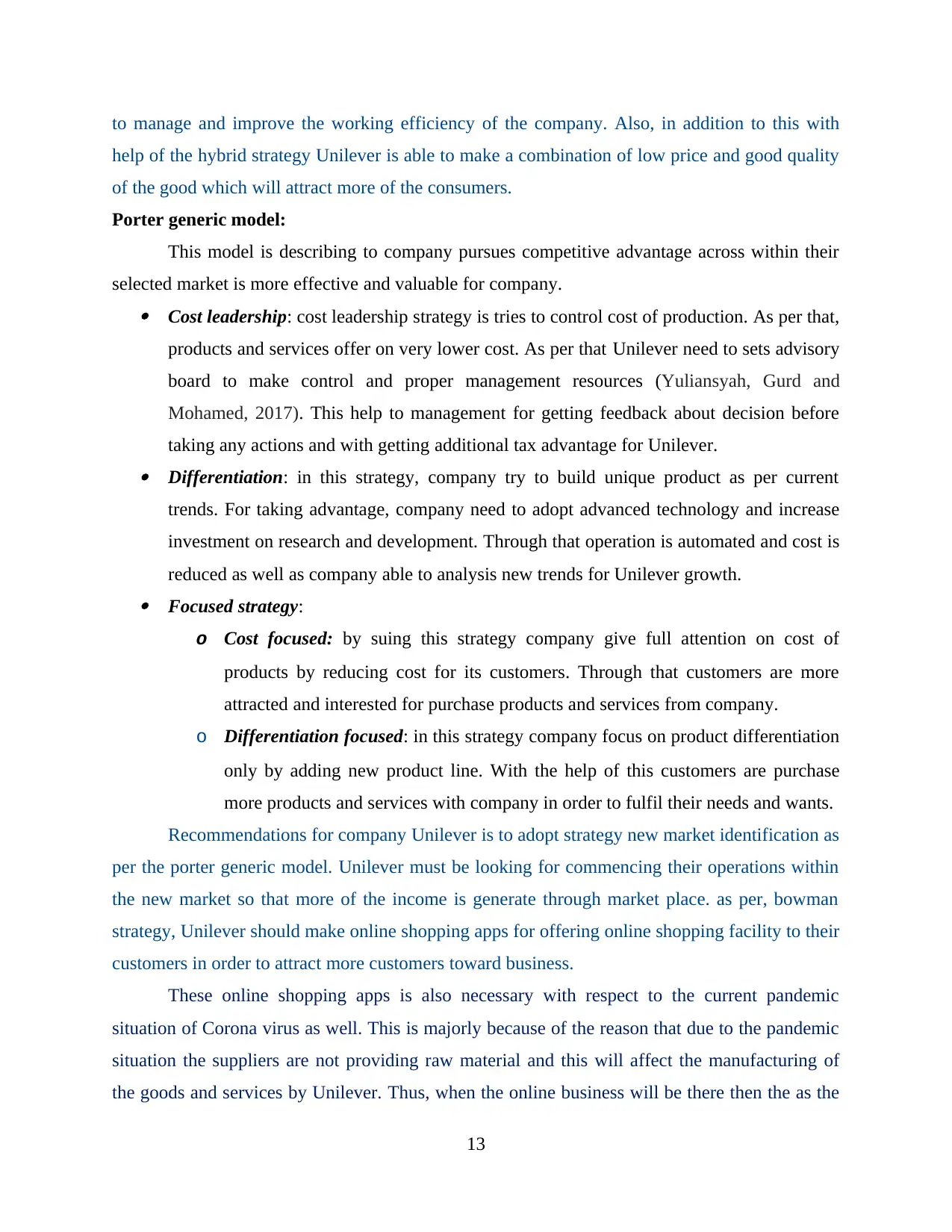
to manage and improve the working efficiency of the company. Also, in addition to this with
help of the hybrid strategy Unilever is able to make a combination of low price and good quality
of the good which will attract more of the consumers.
Porter generic model:
This model is describing to company pursues competitive advantage across within their
selected market is more effective and valuable for company. Cost leadership: cost leadership strategy is tries to control cost of production. As per that,
products and services offer on very lower cost. As per that Unilever need to sets advisory
board to make control and proper management resources (Yuliansyah, Gurd and
Mohamed, 2017). This help to management for getting feedback about decision before
taking any actions and with getting additional tax advantage for Unilever. Differentiation: in this strategy, company try to build unique product as per current
trends. For taking advantage, company need to adopt advanced technology and increase
investment on research and development. Through that operation is automated and cost is
reduced as well as company able to analysis new trends for Unilever growth. Focused strategy:
o Cost focused: by suing this strategy company give full attention on cost of
products by reducing cost for its customers. Through that customers are more
attracted and interested for purchase products and services from company.
o Differentiation focused: in this strategy company focus on product differentiation
only by adding new product line. With the help of this customers are purchase
more products and services with company in order to fulfil their needs and wants.
Recommendations for company Unilever is to adopt strategy new market identification as
per the porter generic model. Unilever must be looking for commencing their operations within
the new market so that more of the income is generate through market place. as per, bowman
strategy, Unilever should make online shopping apps for offering online shopping facility to their
customers in order to attract more customers toward business.
These online shopping apps is also necessary with respect to the current pandemic
situation of Corona virus as well. This is majorly because of the reason that due to the pandemic
situation the suppliers are not providing raw material and this will affect the manufacturing of
the goods and services by Unilever. Thus, when the online business will be there then the as the
13
help of the hybrid strategy Unilever is able to make a combination of low price and good quality
of the good which will attract more of the consumers.
Porter generic model:
This model is describing to company pursues competitive advantage across within their
selected market is more effective and valuable for company. Cost leadership: cost leadership strategy is tries to control cost of production. As per that,
products and services offer on very lower cost. As per that Unilever need to sets advisory
board to make control and proper management resources (Yuliansyah, Gurd and
Mohamed, 2017). This help to management for getting feedback about decision before
taking any actions and with getting additional tax advantage for Unilever. Differentiation: in this strategy, company try to build unique product as per current
trends. For taking advantage, company need to adopt advanced technology and increase
investment on research and development. Through that operation is automated and cost is
reduced as well as company able to analysis new trends for Unilever growth. Focused strategy:
o Cost focused: by suing this strategy company give full attention on cost of
products by reducing cost for its customers. Through that customers are more
attracted and interested for purchase products and services from company.
o Differentiation focused: in this strategy company focus on product differentiation
only by adding new product line. With the help of this customers are purchase
more products and services with company in order to fulfil their needs and wants.
Recommendations for company Unilever is to adopt strategy new market identification as
per the porter generic model. Unilever must be looking for commencing their operations within
the new market so that more of the income is generate through market place. as per, bowman
strategy, Unilever should make online shopping apps for offering online shopping facility to their
customers in order to attract more customers toward business.
These online shopping apps is also necessary with respect to the current pandemic
situation of Corona virus as well. This is majorly because of the reason that due to the pandemic
situation the suppliers are not providing raw material and this will affect the manufacturing of
the goods and services by Unilever. Thus, when the online business will be there then the as the
13
Paraphrase This Document
Need a fresh take? Get an instant paraphrase of this document with our AI Paraphraser
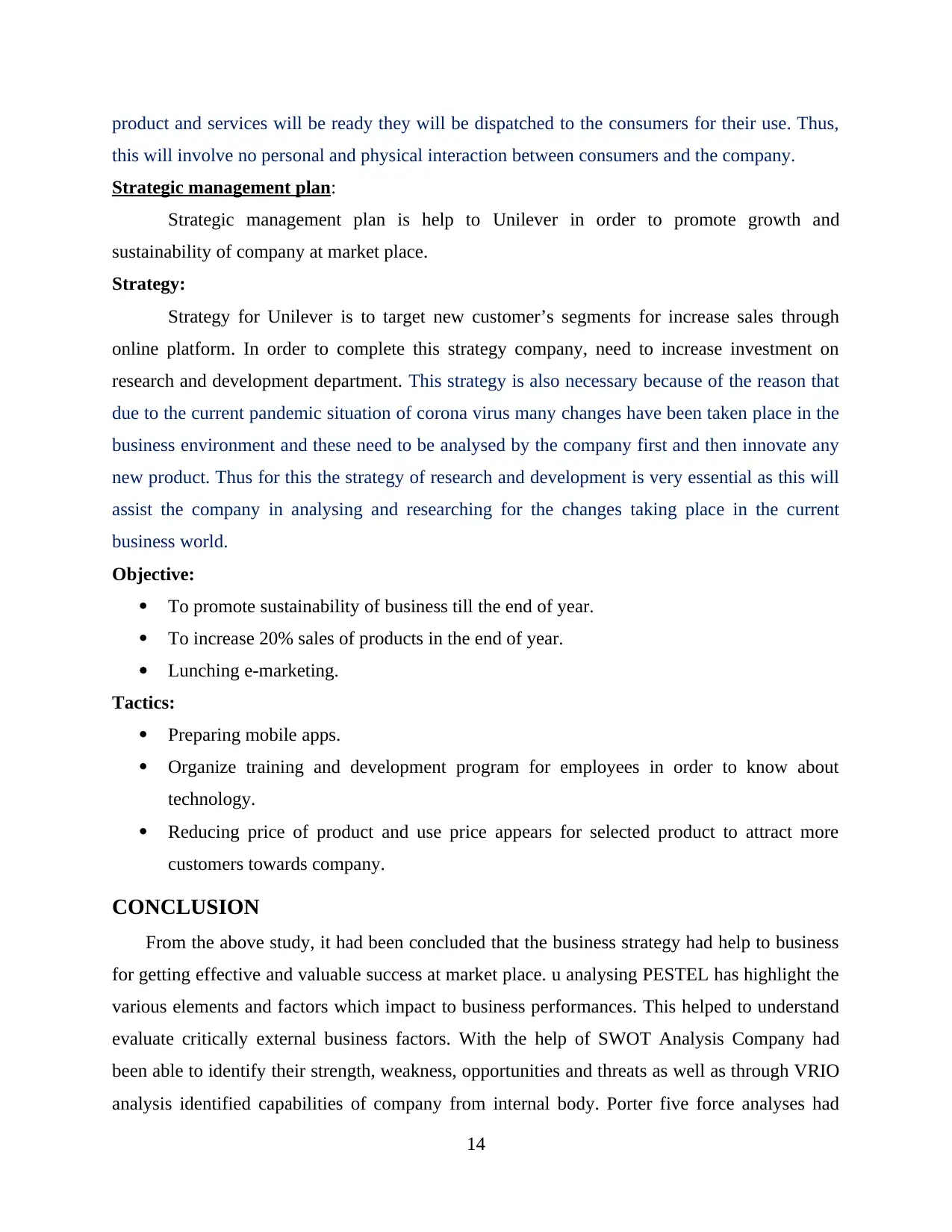
product and services will be ready they will be dispatched to the consumers for their use. Thus,
this will involve no personal and physical interaction between consumers and the company.
Strategic management plan:
Strategic management plan is help to Unilever in order to promote growth and
sustainability of company at market place.
Strategy:
Strategy for Unilever is to target new customer’s segments for increase sales through
online platform. In order to complete this strategy company, need to increase investment on
research and development department. This strategy is also necessary because of the reason that
due to the current pandemic situation of corona virus many changes have been taken place in the
business environment and these need to be analysed by the company first and then innovate any
new product. Thus for this the strategy of research and development is very essential as this will
assist the company in analysing and researching for the changes taking place in the current
business world.
Objective:
To promote sustainability of business till the end of year.
To increase 20% sales of products in the end of year.
Lunching e-marketing.
Tactics:
Preparing mobile apps.
Organize training and development program for employees in order to know about
technology.
Reducing price of product and use price appears for selected product to attract more
customers towards company.
CONCLUSION
From the above study, it had been concluded that the business strategy had help to business
for getting effective and valuable success at market place. u analysing PESTEL has highlight the
various elements and factors which impact to business performances. This helped to understand
evaluate critically external business factors. With the help of SWOT Analysis Company had
been able to identify their strength, weakness, opportunities and threats as well as through VRIO
analysis identified capabilities of company from internal body. Porter five force analyses had
14
this will involve no personal and physical interaction between consumers and the company.
Strategic management plan:
Strategic management plan is help to Unilever in order to promote growth and
sustainability of company at market place.
Strategy:
Strategy for Unilever is to target new customer’s segments for increase sales through
online platform. In order to complete this strategy company, need to increase investment on
research and development department. This strategy is also necessary because of the reason that
due to the current pandemic situation of corona virus many changes have been taken place in the
business environment and these need to be analysed by the company first and then innovate any
new product. Thus for this the strategy of research and development is very essential as this will
assist the company in analysing and researching for the changes taking place in the current
business world.
Objective:
To promote sustainability of business till the end of year.
To increase 20% sales of products in the end of year.
Lunching e-marketing.
Tactics:
Preparing mobile apps.
Organize training and development program for employees in order to know about
technology.
Reducing price of product and use price appears for selected product to attract more
customers towards company.
CONCLUSION
From the above study, it had been concluded that the business strategy had help to business
for getting effective and valuable success at market place. u analysing PESTEL has highlight the
various elements and factors which impact to business performances. This helped to understand
evaluate critically external business factors. With the help of SWOT Analysis Company had
been able to identify their strength, weakness, opportunities and threats as well as through VRIO
analysis identified capabilities of company from internal body. Porter five force analyses had
14

been reflecting about the forces of competitors and competitive edge by analysing factors. At the
end of report, build strategic plan for company by identified best option through Bowman
strategy clock and porter generic model.
15
end of report, build strategic plan for company by identified best option through Bowman
strategy clock and porter generic model.
15

REFERENCES
Books and Journals
Akter, S. and et.al., 2016. How to improve firm performance using big data analytics capability
and business strategy alignment?. International Journal of Production Economics,. 182.
pp.113-131.
Anderson, P.L., 2019. Business strategy and firm location decisions: testing traditional and
modern methods. Business Economics. 54(1). pp.35-60.
Angeloska-Dichovska, M. and Petkovska-Mirchevska, T., 2017. Challenges of the Company in
the New Economy and Development of E-business Strategy. Strategic
Management, .22(2). pp.27-35.
Apenko, S., 2017. Human resource management of innovative projects in the context of business
strategy. Strategic Management. 22(1). pp.3-6.
Bentley-Goode, K.A., Omer, T.C. and Twedt, B.J., 2019. Does business strategy impact a firm’s
information environment?. Journal of Accounting, Auditing & Finance. 34(4). pp.563-
587.
Chen, Y., Eshleman, J.D. and Soileau, J.S., 2017. Business strategy and auditor
reporting. Auditing: A Journal of Practice & Theory. 36(2). pp.63-86.
Duquette, C.E. and Williams, N., 2020. Introduction to the Special Issue on Quality as a
Business Strategy.
Ghemawat, P., 2016. Evolving ideas about business strategy. Business History Review, 90(4),
pp.727-749.
Jansson, H., 2020. International Business Strategy in Complex Markets. Edward Elgar
Publishing.
Johnson, G., 2016. Exploring strategy: text and cases. Pearson Education.
Leischnig, A., Woelfl, S. and Ivens, B., 2016. When does digital business strategy matter to
market performance?.
Leonidou, L.C. and et.al., 2017. Internal drivers and performance consequences of small firm
green business strategy: The moderating role of external forces. Journal of business
ethics. 140(3). pp.585-606.
Lim, E.K., Chalmers, K. and Hanlon, D., 2018. The influence of business strategy on annual
report readability. Journal of Accounting and Public Policy. 37(1). pp.65-81.
Park, Y. and Mithas, S., 2020. Organized Complexity of Digital Business Strategy: A
Configurational Perspective. MIS Quarterly. 44(1).
Razak, N.A. and et.al., 2016. Theories of knowledge sharing behavior in business
strategy. Procedia Economics and Finance. 37(1). pp.545-553.
Soltanizadeh, S. and et.al., 2016. Business strategy, enterprise risk management and
organizational performance. Management Research Review.
Xie, Y. and Cooke, F.L., 2019. Quality and cost? The evolution of Walmart's business strategy
and human resource policies and practices in China and their impact (1996–
2017). Human Resource Management. 58(5). pp.521-541.
Yuliansyah, Y., Gurd, B. and Mohamed, N., 2017. The significant of business strategy in
improving organizational performance. Humanomics.
ONLINE
16
Books and Journals
Akter, S. and et.al., 2016. How to improve firm performance using big data analytics capability
and business strategy alignment?. International Journal of Production Economics,. 182.
pp.113-131.
Anderson, P.L., 2019. Business strategy and firm location decisions: testing traditional and
modern methods. Business Economics. 54(1). pp.35-60.
Angeloska-Dichovska, M. and Petkovska-Mirchevska, T., 2017. Challenges of the Company in
the New Economy and Development of E-business Strategy. Strategic
Management, .22(2). pp.27-35.
Apenko, S., 2017. Human resource management of innovative projects in the context of business
strategy. Strategic Management. 22(1). pp.3-6.
Bentley-Goode, K.A., Omer, T.C. and Twedt, B.J., 2019. Does business strategy impact a firm’s
information environment?. Journal of Accounting, Auditing & Finance. 34(4). pp.563-
587.
Chen, Y., Eshleman, J.D. and Soileau, J.S., 2017. Business strategy and auditor
reporting. Auditing: A Journal of Practice & Theory. 36(2). pp.63-86.
Duquette, C.E. and Williams, N., 2020. Introduction to the Special Issue on Quality as a
Business Strategy.
Ghemawat, P., 2016. Evolving ideas about business strategy. Business History Review, 90(4),
pp.727-749.
Jansson, H., 2020. International Business Strategy in Complex Markets. Edward Elgar
Publishing.
Johnson, G., 2016. Exploring strategy: text and cases. Pearson Education.
Leischnig, A., Woelfl, S. and Ivens, B., 2016. When does digital business strategy matter to
market performance?.
Leonidou, L.C. and et.al., 2017. Internal drivers and performance consequences of small firm
green business strategy: The moderating role of external forces. Journal of business
ethics. 140(3). pp.585-606.
Lim, E.K., Chalmers, K. and Hanlon, D., 2018. The influence of business strategy on annual
report readability. Journal of Accounting and Public Policy. 37(1). pp.65-81.
Park, Y. and Mithas, S., 2020. Organized Complexity of Digital Business Strategy: A
Configurational Perspective. MIS Quarterly. 44(1).
Razak, N.A. and et.al., 2016. Theories of knowledge sharing behavior in business
strategy. Procedia Economics and Finance. 37(1). pp.545-553.
Soltanizadeh, S. and et.al., 2016. Business strategy, enterprise risk management and
organizational performance. Management Research Review.
Xie, Y. and Cooke, F.L., 2019. Quality and cost? The evolution of Walmart's business strategy
and human resource policies and practices in China and their impact (1996–
2017). Human Resource Management. 58(5). pp.521-541.
Yuliansyah, Y., Gurd, B. and Mohamed, N., 2017. The significant of business strategy in
improving organizational performance. Humanomics.
ONLINE
16
Secure Best Marks with AI Grader
Need help grading? Try our AI Grader for instant feedback on your assignments.
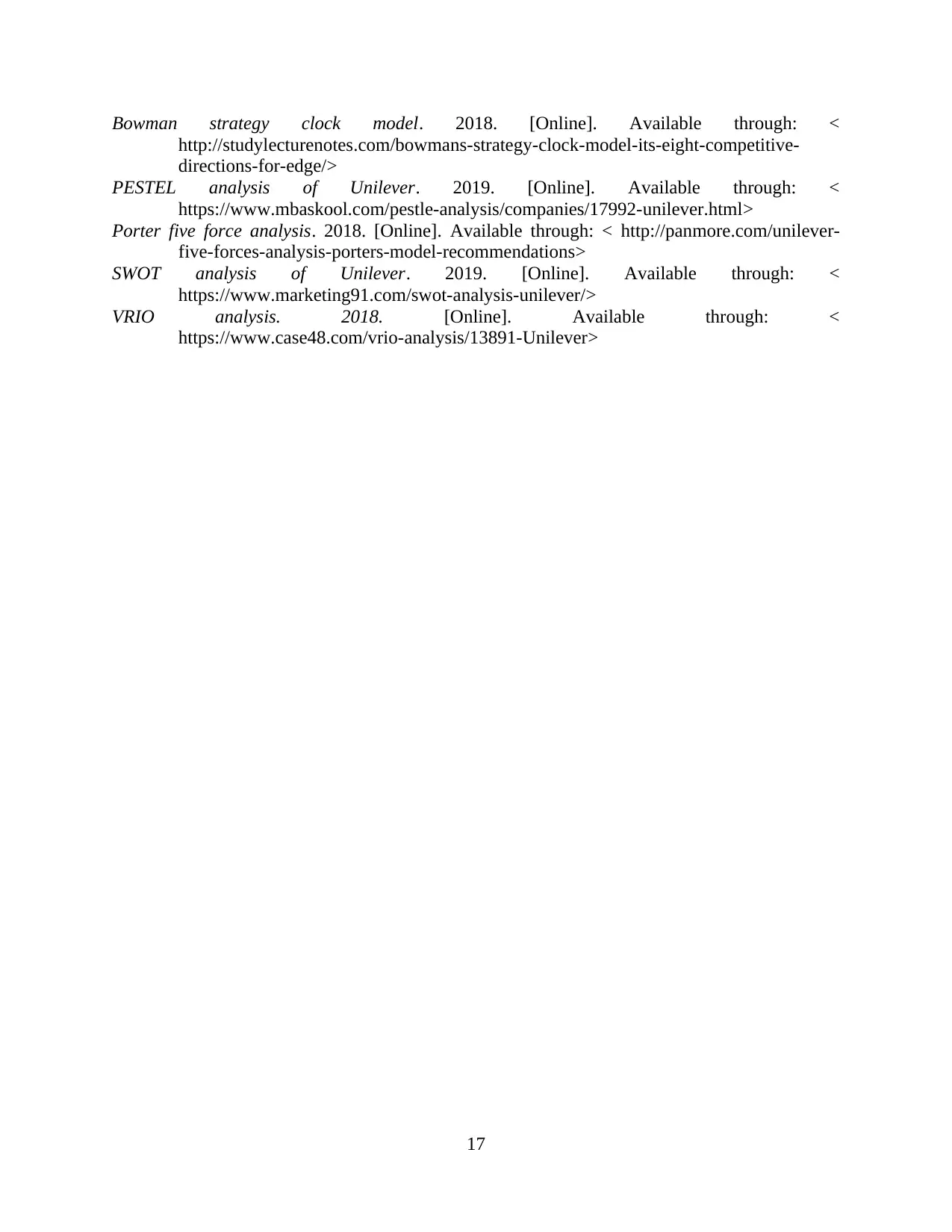
Bowman strategy clock model. 2018. [Online]. Available through: <
http://studylecturenotes.com/bowmans-strategy-clock-model-its-eight-competitive-
directions-for-edge/>
PESTEL analysis of Unilever. 2019. [Online]. Available through: <
https://www.mbaskool.com/pestle-analysis/companies/17992-unilever.html>
Porter five force analysis. 2018. [Online]. Available through: < http://panmore.com/unilever-
five-forces-analysis-porters-model-recommendations>
SWOT analysis of Unilever. 2019. [Online]. Available through: <
https://www.marketing91.com/swot-analysis-unilever/>
VRIO analysis. 2018. [Online]. Available through: <
https://www.case48.com/vrio-analysis/13891-Unilever>
17
http://studylecturenotes.com/bowmans-strategy-clock-model-its-eight-competitive-
directions-for-edge/>
PESTEL analysis of Unilever. 2019. [Online]. Available through: <
https://www.mbaskool.com/pestle-analysis/companies/17992-unilever.html>
Porter five force analysis. 2018. [Online]. Available through: < http://panmore.com/unilever-
five-forces-analysis-porters-model-recommendations>
SWOT analysis of Unilever. 2019. [Online]. Available through: <
https://www.marketing91.com/swot-analysis-unilever/>
VRIO analysis. 2018. [Online]. Available through: <
https://www.case48.com/vrio-analysis/13891-Unilever>
17
1 out of 17
Related Documents
Your All-in-One AI-Powered Toolkit for Academic Success.
+13062052269
info@desklib.com
Available 24*7 on WhatsApp / Email
![[object Object]](/_next/static/media/star-bottom.7253800d.svg)
Unlock your academic potential
© 2024 | Zucol Services PVT LTD | All rights reserved.




